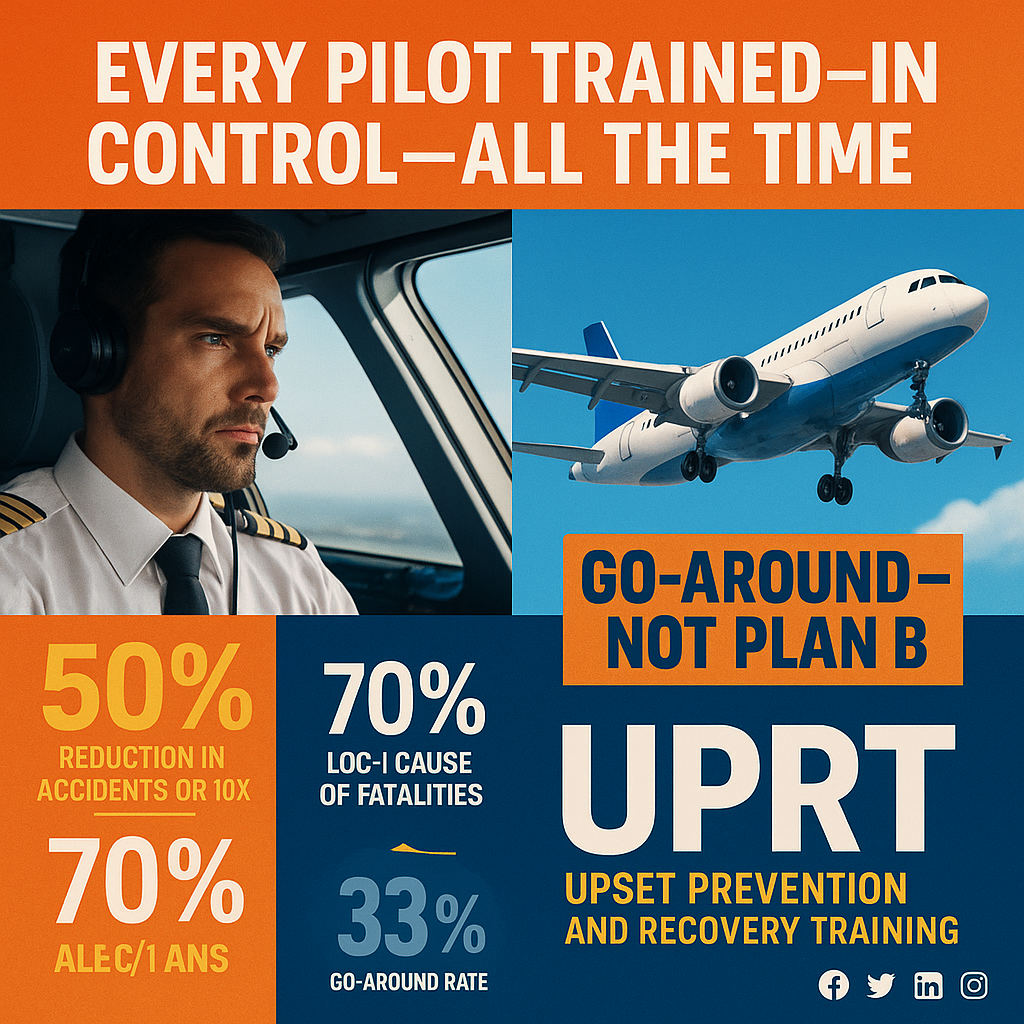Safety is a critical component of any organization’s operations, and Upset Prevention and Recovery Training (UPRT) can help to enhance safety in an organization’s Safety Management System (SMS). UPRT is a specialized form of training that focuses on preventing and recovering from aircraft upsets. Integrating UPRT into an SMS helps organizations to create operational excellence while mitigating risk. In this article, we will discuss what UPRT is, the importance of incorporating it into your SMS, benefits of integration with an SMS, strategies for implementation, challenges to consider during integration and how to measure the success of integrating UPRT in your safety management system. We will also provide examples of successful integrations with operators’ safety management systems.
1. What is UPRT and how can it benefit your SMS
UPRT, or Upset Prevention and Recovery Training, is an incredibly effective SMS training module designed to reduce exposure to significant operational risks. UPRT helps operators build the skills needed to mitigate any dominant risks posed by their SMS. Combined with regular SMS assessments, UPRT principles help create a culture of safety while empowering operations of all sizes to remain safe and compliant.  Offered as an SMS-approved course, UPRT training is proving itself instrumental in mitigating high-risk operations and helping safety managers identify problems which may be outside the boundaries of traditional SMS procedures. With UPRT implementation, a SMS will receive protection against risk exposure while ensuring successful navigation of challenging aviation scenarios. By investing in UPRT training pilots can achieve greater levels of proficiency in navigating hazardous flight conditions with minimal risk and superior safety outcomes for overall SMS performance.
Offered as an SMS-approved course, UPRT training is proving itself instrumental in mitigating high-risk operations and helping safety managers identify problems which may be outside the boundaries of traditional SMS procedures. With UPRT implementation, a SMS will receive protection against risk exposure while ensuring successful navigation of challenging aviation scenarios. By investing in UPRT training pilots can achieve greater levels of proficiency in navigating hazardous flight conditions with minimal risk and superior safety outcomes for overall SMS performance.
2. The importance of integrating UPRT into your safety management system
 UPRT is becoming increasingly important, as it provides a foundation to build upon in order to manage and mitigate high-risk operations. UPRT is an invaluable tool for safety managers due to its ability to provide heightened awareness of operational risks while equipping pilots with the skills they need to effectively manage these risks. In addition, incorporating UPRT into a SMS helps to mitigate the risk of non-compliance with FAA regulations by providing a comprehensive safety approach that focuses on preventive measures. UPRT helps operators ensure their operations remain safe and compliant in all weather conditions, regardless of experience level.
UPRT is becoming increasingly important, as it provides a foundation to build upon in order to manage and mitigate high-risk operations. UPRT is an invaluable tool for safety managers due to its ability to provide heightened awareness of operational risks while equipping pilots with the skills they need to effectively manage these risks. In addition, incorporating UPRT into a SMS helps to mitigate the risk of non-compliance with FAA regulations by providing a comprehensive safety approach that focuses on preventive measures. UPRT helps operators ensure their operations remain safe and compliant in all weather conditions, regardless of experience level.
3. Benefits of incorporating UPRT into an SMS
UPRT implementation into a SMS can provide numerous benefits, including:
• Improved safety performance of pilots and operations
• Increased awareness of high-risk scenarios
• Enhanced communication between aircraft crew members
• Improved situational awareness during flight operations
• Reduced risk of non-compliance with FAA regulations
By incorporating UPRT into their SMS, operators can reduce the potential for catastrophic incidents due to human error and gain insight into aviation risks which may not be evident through traditional safety management methods.
4. Strategies for implementing UPRT into an SMS
Integrating UPRT into an SMS is a straightforward process and can be achieved through the following steps:
• Step 1 – Integrate proven-effective UPRT within the operator’s approved SMS.
• Step 2 – Develop a comprehensive UPRT training program based on best practices, which should include classroom, on-aircraft, and simulator training.
• Step 3 – Ensure the program is designed to meet FAA requirements that follow the guidances issued in Advisory Circulars AC 120-111 Upset Prevention and Recovery Training and AC 120-109A Stall Prevention and Recovery Training.
• Step 4 – Offer UPRT training to all department pilots on an ongoing basis, ensuring that initial and recurrent UPRT training is conducted in accordance with approved procedures.
• Step 5 – Monitor performance post-training to ensure the effectiveness of the training and that pilots are adhering to UPRT principles.
By following these steps, operators can ensure the successful integration of UPRT into their SMS and reduce risk exposure due to human error.
5. Challenges to consider when integrating UPRT with an SMS
Integrating UPRT with an SMS can present a few challenges, including:
• Accessibility to approved UPRT training programs
• Training cost associated with on-aircraft training and simulator sessions
• Determining how much training is necessary for each pilot. Typically, pilots must initially complete three days of training by the company's SMS-approved UPRT provider with several months of being hired and then ensure they stay current with 1-day refresher courses every two to three years.
It is also important to consider the amount of time it takes to find, audit, customize your UPRT training using a specialized provider, as well as the potential impact this integration may have on a SMS’s resources.
In order to minimize these challenges, operators should ensure they create an appropriate budget and timeline to accommodate the costs associated with UPRT training while also taking into account any additional time required for UPRT provider audit and program approval. By doing so, operators can ensure a smoother transition into UPRT integration and a more efficient SMS.
6. How to measure the success of incorporating UPRT in a safety management system
Measuring the success of UPRT integration into an SMS can be done by assessing the following:
• Reduction in pilot-error related incidents
• Increased awareness of high-risk scenarios amongst pilots
• Improved communication between aircraft crew members
• Enhanced situational awareness during flight operations
By assessing these metrics, operators can gain insight into how well the UPRT program is working and determine if any additional training is necessary. Additionally, measuring the success of integrating UPRT into an SMS helps to ensure that operations remain safe and compliant with FAA regulations.
7. Examples of successful integration of UPRT with an operator’s safety management system
One example of successful integration of UPRT into an SMS is that of American Airlines. Following the introduction of UPRT, American Airlines saw a reduction in pilot-error related incidents and an increased awareness amongst pilots about high-risk scenarios. Additionally, there was an improvement in communication between aircraft crew members and more effective utilization of flight simulators. All of these factors resulted in American Airlines having a more efficient and reliable SMS that is better able to respond to safety risks.
Another example of successful integration of UPRT with an operator’s SMS is that of United Airlines. After the addition of UPRT training, United saw a decrease in incidents and an improvement in communication between the aircraft crew. The training also resulted in better situational awareness and a more efficient use of flight simulators. These successes show that when UPRT is properly implemented into an operator’s SMS, it can result in safer operations and less risk exposure due to pilot error.
By following these examples, operators can ensure that their UPRT integration is successful and their SMS remains compliant with FAA regulations.
Conclusion
In conclusion, the integration of UPRT into an SMS is essential for the safe and efficient operation of aircraft. By following the steps outlined in this article, operators can ensure a successful transition into incorporating UPRT with their current SMS and reduce risk exposure due to human error. Additionally, by measuring for success, operators can evaluate how well UPRT is working and determine if any additional training or adjustments are necessary. With careful planning and consideration, operators can ensure that their SMS remains compliant with FAA regulations, such as ACs 120-111 and 120-109A, assuring minimized risk associate with Loss of Control In-flight (LOC-I) for all flight operations.
Aviation Performance Solutions - Industry Leading UPRT Provider
If you are looking for an experienced and reliable provider to develop an ideal UPRT program tailored to the specifics of your flight operation, Aviation Performance Solutions (APS) is the perfect choice for you. For more than 25 years, APS has led the industry with their superior UPRT services for airlines, government agencies, corporate flight departments and insurance companies. Our reputation is founded on providing only top-notch products and service to make sure our customers are taken care of. With a team of certified instructors and seasoned professionals, APS prides itself on its comprehensive approach to UPRT training and its commitment to safety. APS has successfully developed, implemented, and monitored successful UPRT programs for operators large and small around the world.
So if you are looking for a reliable provider of UPRT services, look no further than Aviation Performance Solutions.






Blog comments